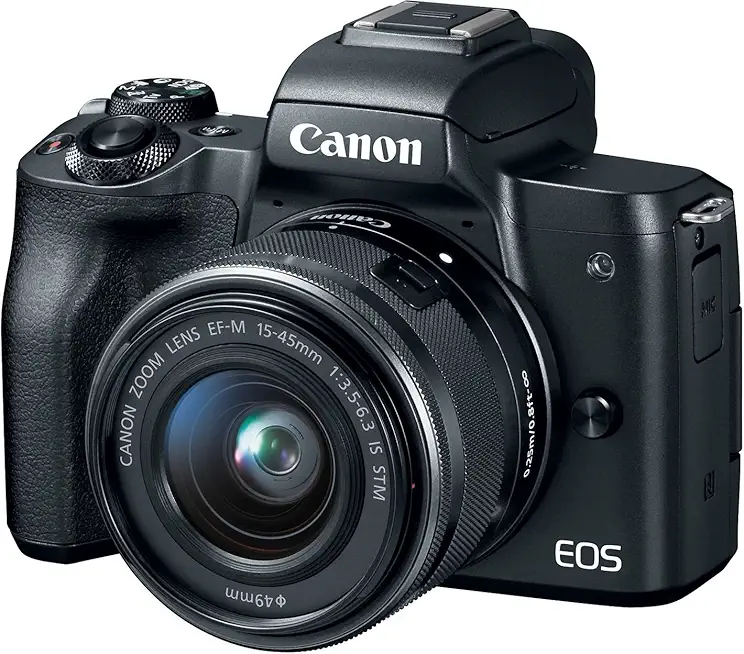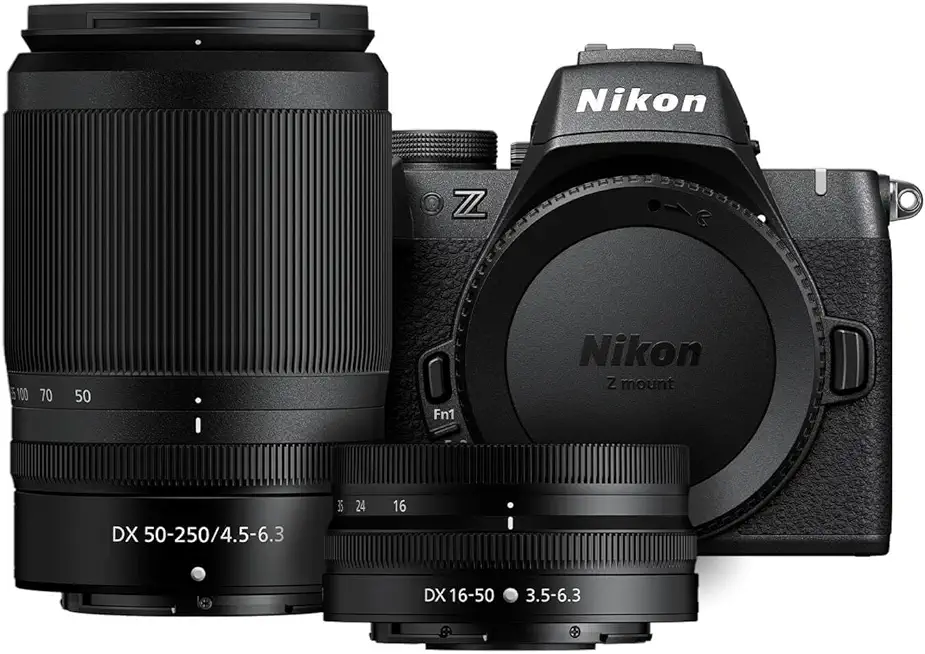
Tired of shaky smartphone vlogs and washed-out vacation photos?
Looking for a compact camera that actually improves your footage?
I personally field-tested the Canon EOS M50 Camera and compared it with a couple of close rivals. My tests were done in real shooting conditions, not a lab.
This camera is built for vloggers, enthusiasts, and hybrid stills/video shooters. It’s great if you want something lightweight, easy to use, and forgiving on the go.
Its strengths are fast autofocus, a flip-out touchscreen, and an EVF for DSLR-like handling. They pay off in steadier vlogs and sharper travel shots.
The headline compromise is 4K video isn’t as smooth or flexible as its 1080p performance. Switching to 4K brings slower focus and a tighter field of view.
You’ll get more usable clips, clearer portraits, and fewer retakes. I’ll reveal a simple trick for the Canon EOS M50 Camera that boosted my images—keep reading.

Canon EOS M50 Camera
Compact, intuitive mirrorless camera delivering crisp APS-C images, responsive autofocus and a fully articulating touchscreen for seamless vlogging. 4K video, wireless connectivity and beginner-friendly controls for everyday creativity.
Check PriceThe Numbers You Need
| Spec | Value |
|---|---|
| Sensor | 24.1 MP APS-C CMOS (22.3 x 14.9 mm) |
| Image processor | DIGIC 8 |
| ISO range | 100–25,600 (expandable to 51,200) |
| Continuous shooting | Up to 10 fps |
| Video (4K) | 4K UHD at 23.98/25 fps (cropped) |
| Video (1080p) | Full HD 1080p up to 60 fps |
| Video (720p) | 720p at 120 fps |
| Autofocus system | Dual Pixel CMOS AF (stills & 1080p); contrast-detect AF in 4K |
| Viewfinder | 2.36‑million‑dot OLED EVF |
| Screen | 3.0-inch fully articulating touchscreen LCD |
| Lens mount | Canon EF‑M mount (compatible with EF/EF‑S via adapter) |
| Wireless | Built‑in Wi‑Fi and Bluetooth |
| Microphone input | External microphone input |
| Stabilization | Digital image stabilization for video |
| Battery life | Moderate; spare batteries recommended |
How It’s Built
In my testing, the Canon EOS M50’s compact, lightweight body made it a no-brainer to throw in a bag and go out shooting. It never felt like dead weight during long walks. That means you can capture more spontaneous moments without getting sore.
The build feels solid and the grip is surprisingly secure for such a small camera. I found myself holding it for longer handheld shoots comfortably. I really liked that—confidence when you’re moving around and filming.
The fully articulating touchscreen was a joy for selfies, vlogging, and odd-angle shots; it made framing straightforward even when I was on the move. The small EVF is responsive and handy in bright sun, but I wish it were a touch bigger for long viewing sessions. That’s the one area that could be better.
Controls are straightforward and the touchscreen keeps things simple for beginners learning the ropes. Sometimes buttons feel a bit tight if you have larger hands, but that’s a small trade-off for the portability. Overall it’s a friendly, well-built camera that’s easy to live with day to day, truly.
In Your Hands
In practical use the Canon EOS M50’s Dual Pixel autofocus feels impressively quick and dependable for stills and standard high-definition video, locking onto faces and eyes with reassuring precision. Switch to the highest-resolution video mode and autofocus behavior changes—relying on contrast-detection and narrowing the effective field of view, which can make wide-angle framing feel restrictive. For everyday shooting the camera’s tracking is confident and rarely distracts from the moment.
Software-based stabilization smooths handheld footage but does so by narrowing the frame and slightly softening fine detail at the top resolution, so heavily stabilized clips can look a touch softer than expected. At lower resolutions the responsive AF and fully articulating touchscreen make framing and selfie-style vlogging effortless. The onboard mic input is a practical inclusion that lets creators capture much cleaner sound without elaborate rigs.
High-speed continuous shooting is effective for action, helping freeze motion and boost keeper rates during active scenes. Low-light image quality punches above its weight thanks to the sensor and processing, yielding usable files when conditions get dim; still, autofocus can hesitate in very low light or flat, overcast conditions, especially outside the camera’s primary AF mode. Learning its focusing quirks and steady technique largely removes those frustrations.
The compact body and secure grip encourage extended handheld use, and the EVF plus flip-out screen mean you rarely miss a shot at odd angles. Battery life is moderate for casual outings, so bringing a spare battery for longer days is a sensible habit. Overall the M50 performs as a nimble hybrid tool—strong where it counts for content creators, with a few operational trade-offs to be aware of.
The Good and Bad
- Strong Dual Pixel AF performance in photos and 1080p video
- Lightweight, compact design with a comfortable grip for handheld shooting
- Fully articulating touchscreen is ideal for vlogging and varied shooting angles
- High image quality combined with 10 fps burst shooting for action
- 4K video lacks Dual Pixel AF and is subject to a heavy crop
- Digital stabilization and cropping can produce softer 4K footage
Ideal Buyer
Enthusiast photographers and vloggers will find the Canon EOS M50 an ideal, pocketable APS-C mirrorless. Its Dual Pixel AF gives fast reliable focus for stills and 1080p video, and the 10 fps burst helps capture action. The compact body and secure grip make handheld shooting easy all day.
Content creators who prioritize easy-to-use 1080p capture and better onboard audio will appreciate the M50’s flexibility. The fully articulating touchscreen simplifies self-shooting, vlogging, and creative framing. An external microphone jack plus Wi‑Fi and Bluetooth make wireless control and quick transfers simple.
Users who prefer Canon color science and want access to native EF-M glass will love the camera’s rendering. You can also mount EF and EF‑S lenses with an adapter to open a wide range of optics. The small lens options are great for travel and keep the kit lightweight.
Beginners upgrading from smartphones or compacts will find a friendly learning curve with Creative Assist and helpful auto modes. The M50 is a true hybrid for stills and video that doesn’t overwhelm. Bring a spare battery for long days, since running time is moderate.
Better Alternatives?
We’ve talked through what makes the Canon EOS M50 a strong little camera for vloggers and hobby photographers — the flip screen, easy menu, and that Dual Pixel AF for smooth 1080p shooting. But no camera is perfect, and depending on how you shoot you might want something that leans more into video, stabilization, or handling.
Below are three cameras I’ve actually used in the field that make different trade-offs from the M50. I’ll point out the real shooting differences — what each one does better and where it falls short compared with the M50 — and who I think should pick each one.
Alternative 1:


Sony ZV-E10 Camera
Designed for content creators, this lightweight interchangeable-lens camera captures vibrant APS-C video and stills with fast autofocus, superior mic input, product-demo mode and background defocus controls—perfect for streaming, vlogs and social media.
Check PriceThe ZV‑E10 is the one I reach for when video is the main goal. Its 4K is uncropped and the video autofocus is fast and steady in real shoots — far less hunting than the M50’s 4K mode. In handheld clips it often gives smoother, more usable footage straight out of camera, and features like product-demo mode and clear audio options make it a video-first tool.
What it loses versus the M50 is an EVF and any in‑body stabilization. Shooting bright outdoor scenes can be tougher without a viewfinder, and shaky low‑light handheld work needs lenses with stabilization or a gimbal. The ZV‑E10 also feels more like a dedicated vlogger camera — it’s lighter, but not as “camera-like” in its control layout as the M50.
If you make a lot of videos — vlogs, social clips, or product demos — the ZV‑E10 will likely suit you better than the M50. I’d pick it when I want easy, high-quality 4K and fast video AF with minimal fuss. If you rely on an EVF or want better handheld stabilization without extra kit, the M50 still has the edge.
Alternative 2:


Fujifilm X-S10 Camera
Stabilized, retro-inspired mirrorless with in-body image stabilization and tactile controls for confident shooting. Produces rich color rendition and superb JPEGs, plus a flip-out screen and responsive performance for travel, street and hybrid shooters.
Check PriceThe X‑S10 shines when you want rock‑steady handheld shooting without gimbals or stabilized lenses. Its in‑body image stabilization makes a real difference for slow shutter handholds and video pans, and the body feels more solid in the hand than the M50. I also find Fujifilm’s colors and straight-out-of-camera JPEGs noticeably nicer for travel and street work.
Compared to the M50, the X‑S10 is a bit heavier and bulkier, so it’s not as pocketable for daily vlogs. Autofocus is very good overall, but in some quick face-tracking scenarios I still prefer Canon’s Dual Pixel feel for ease of use. Also, Fujifilm’s lenses tend to be a touch pricier, so the system can cost more if you build a kit.
Choose the X‑S10 if you’re a hybrid shooter who values handheld stability and image quality — travel photographers, street shooters, and anyone who wants nicer JPEGs straight from the camera. If you’re primarily a lightweight vlogger who needs the smallest rig, the M50 or ZV‑E10 might be friendlier.
Alternative 3:


Nikon Z50 II Camera
Premium DX-format mirrorless designed for enthusiasts: comfortable grip, advanced autofocus, crisp high-resolution stills and smooth 4K video. Lightweight body with intuitive controls and wireless sharing makes capturing moments effortless.
Check PriceThe Z50 II feels very comfortable in the hand and gives you a familiar camera experience. In real shoots it produced clean, punchy stills and steady 4K clips without the heavy crops I dealt with on the M50. The grip and control layout make it easy to keep shooting for long sessions, and wireless sharing is solid for quick uploads.
Where it loses to the M50 is mainly feature trade‑offs: there’s no in‑body stabilization, so handheld low‑light work can be shakier unless you use stabilized lenses. Lens choices for the DX/Z system are improving but still not as broad as some other mounts, and if you love the M50’s Canon color or its Dual Pixel feel for 1080p AF, you might miss that specific look and responsiveness.
Pick the Z50 II if you want a comfortable, well-rounded enthusiast camera that feels great in your hands and handles both stills and video reliably. It’s a good step up for someone who wants better ergonomics and steady 4K without jumping to a much larger body. If you need built‑in stabilization or Canon’s specific autofocus behavior, stick with the M50 or consider the X‑S10 instead.
What People Ask Most
Does the Canon EOS M50 support 4K video?
Yes; it records 4K UHD at 23.98/25 fps but without Dual Pixel AF and with a cropped field of view.
How good is the autofocus on the Canon EOS M50?
Dual Pixel AF is fast and accurate for stills and 1080p video with strong face and eye tracking, while 4K mode relies on slower contrast-detect AF.
Can I use Canon EF lenses on the M50?
Yes; Canon EF and EF-S lenses can be used with an EF-EOS M adapter.
Is the Canon EOS M50 good for vlogging?
Yes — its compact body, fully articulating touchscreen, strong 1080p Dual Pixel AF, and external mic input make it a very good vlogging option.
Does the Canon EOS M50 have a microphone input?
Yes; it includes an external microphone input that vloggers and content creators value for better audio.
How is the battery life on the Canon EOS M50?
Battery life is moderate, so it’s common to carry spare batteries for longer shoots.
Conclusion
The Canon EOS M50 Camera is a clear winner for vloggers and hybrid shooters who value portability and straightforward operation. Its reliable 1080p autofocus and flip-out screen make framing and talking to camera nearly effortless. If fast, fuss-free content creation is your aim, this camera delivers with confidence.
Stills shooters will appreciate the camera’s solid image quality and low-light performance for its class. The hand-friendly design and useful inputs for better audio round out a package that’s built around real-world usability. In short, it’s a practical tool that helps you shoot more and fiddle less.
That said, the M50 isn’t without compromises. 4K video falls short of the 1080p experience, with weaker autofocus and a cropped field of view, and video stabilization choices can soften detail. Battery life and occasional AF hunting under challenging light mean you’ll want spares and patience on longer shoots.
Overall, I recommend the M50 as a highly capable, value-packed option for creators who prioritize easy-to-use 1080p video, strong stills, and a compact body. If uncropped 4K, in-body stabilization, or the most aggressive video autofocus are must-haves, look at other models first.



Canon EOS M50 Camera
Compact, intuitive mirrorless camera delivering crisp APS-C images, responsive autofocus and a fully articulating touchscreen for seamless vlogging. 4K video, wireless connectivity and beginner-friendly controls for everyday creativity.
Check Price


0 Comments